HIXTON
silIcified sandstone
WISCONSIN
PRIVATE
COLLECTIONS
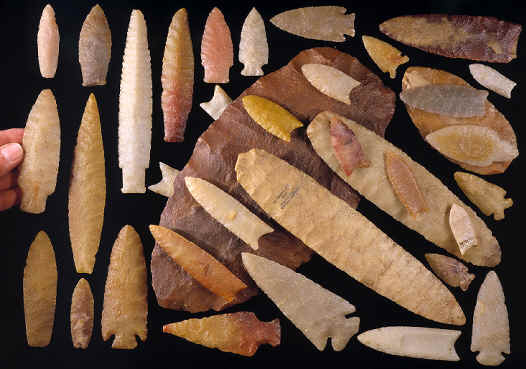
CLICK ON PICTURE FOR
A MUCH LARGER IMAGE
PALEO, ARCHAIC AND WOODLAND
ARTIFACTS
MADE OF HIXTON
MOST OF THEM WERE FOUND IN WISCONSIN
MATERIAL SOURCE---WISCONSIN
PRIVATE COLLECTION
Hixton
Silicified Sandstone, which is also known as Hixton quartzite, sugar
quartz or just Hixton, is native to Wisconsin. In fact, one of the largest
prehistoric quarry sites in the upper Midwest is a Hixton outcrop. This
site is called Silver Mound and is located in Jackson County about 3 and
1/2 miles northeast of the town of Hixton. Silver Mound is located in
Wisconsin's non-glaciated "Driftless Area". This site, which is
shaped like a boomerang, rises to
an elevation of 1250 feet and is 1/2 mile in length. It received its name
from early Europeans who believed this site was excavated by Native
Americans to mine silver. In fact, Europeans have dug there, off and on,
looking for silver for approximately 200 hundred years.
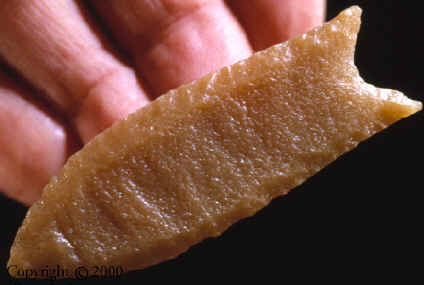
CLICK ON PICTURE FOR
A LARGE TRIPLE EXPOSED IMAGE
FOLSOM POINT
A
CAST OF THIS POINT IS AVAILABLE
SOUTHWESTERN WISCONSIN
PRIVATE COLLECTION
This Folsom point was found sometime before 1950 in either Grant or
Richland Counties in southwestern Wisconsin. It's made of a beautifully
colored translucent piece of orange Hixton Silicified Sandstone that is
believed to have come from the Silver Mound quarry site. This Folsom point
measures 2 5/8 inches long.
Hixton Silicified Sandstone was utilized by all cultures
living in Wisconsin from Clovis to the Mississippian period. The area
around the Silver Mound quarry site is littered with mainly thinning
flakes that were left behind from the manufacture of preforms. The lighter
and more easily transportable early stage preforms were then carried back to
habitation sites where they were eventually flaked into finished tools. A
certain percentage of these preforms were probably used as a commodity and
traded throughout the Great Lakes region.
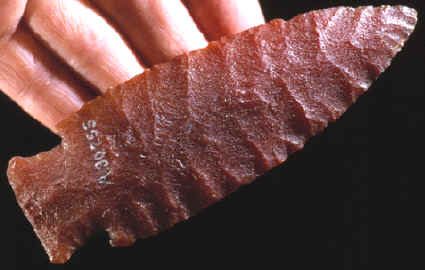
CLICK ON PICTURE FOR
A LARGE DOUBLE EXPOSED IMAGE
HARDIN BARBED POINT
WISCONSIN
PRIVATE COLLECTION
This Early Archaic period Hardin Barbed point is made of one of the rarest
colors of Hixton Silicified Sandstone. The less common colors are the
darker browns, black, darker oranges, lavender, pink, and red. The most
common colors are white, pale orangish brown, light brown, tan and light
gray. The prehistoric mining at Silver Mound was accomplished by
digging pits. The majority of these pits were dug on top and at the back
edge of the slopes and along the vertical faces. These pits average
six to fifteen feet in diameter. Quarrying was done with the use of
quartzite hammerstones weighing five to ten pounds. The prehistoric
quarrymen broke their way down through layers of silicified sandstone
until they reached unweathered stone suitable for making stone tools.

CLICK ON PICTURE FOR
A LARGE DOUBLE EXPOSED IMAGE
LARGE PREFORM
WISCONSIN
FLOYD RITTER COLLECTION
This is an unfinished artifact in a preform stage of manufacture. It would
have probably been finished into some type of large knife. This is one of
the largest bifaces known that is made of Hixton Silicified Sandstone. It
measures 14 3/16 inches long (36 cm).
Hixton is a very
compact stone with a hardness of 6.5 to 7.0 on the Mohs scale. It can have
a translucency of 5 mm or more. The quartz sand grains are cemented
together with opal-chalcedony cement and microscopic inclusions can
include hematite, tourmaline, apatite, biotite, rutile and almandite or
garnet (Porter 1961).
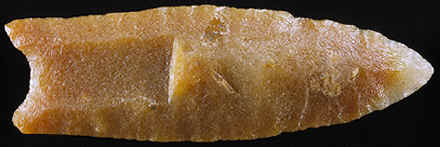
CLICK ON PICTURE FOR
VERY LARGE DOUBLE IMAGE
CLOVIS POINT
A
CAST OF THIS POINT IS AVAILABLE
FULTON COUNTY, ILLINOIS
MAURY MEADOWS COLLECTION
This is one of the prettiest fluted points I have seen from the state of Illinois.
That's because it's made of a particularly colorful variety of
orange Hixton Silicified Sandstone. Clovis people are known to have
utilized some of the best quality and most colorful stone to make their
tools. This spear point measures 4 1/16 inches long.
When Hixton is heated or "heat treated", as many cultures have
done to various types of cherts for the last 10,000 years or more, it
changes it's characteristics. This technique was used to make the stone
easier to flake with an added bonus of usually making the color of the
stone more enhanced and sometimes completely changing the color. But with
Hixton, even though it can enhance the color, "heat treating can
weaken the opal-chalcedony cement encasing the sand grains making it too
brittle to use (Behm and Faulkner 1974).
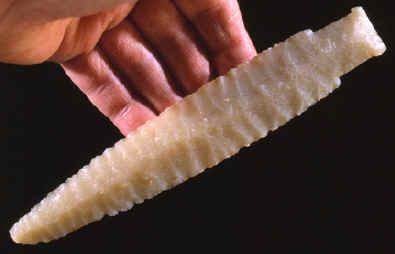
CLICK ON PICTURE FOR
MORE INFORMATION (and cast)
"EARED" EDEN POINT
JACKSON COUNTY, WISCONSIN
PRIVATE COLLECTION
This is one of the best examples of a Late Paleo "Eared" Eden
point ever found in Wisconsin. It's made of a more common color variety of
Hixton Silcified Sandstone. It measures 6 7/8 inches long.
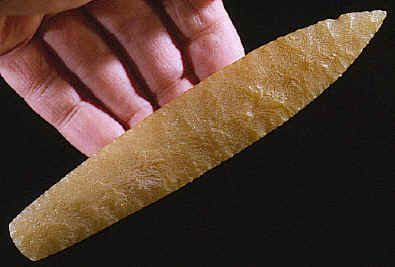
CLICK ON PICTURE FOR
MORE INFORMATION (and cast)
AGATE BASIN POINT
STEPHENSON COUNTY, ILLINOIS
PRIVATE COLLECTION
This Agate Basin point was found by a bulldozer operator in 1950 along
with two other Agate Basin points that were made of white Burlington
chert. This spear point is made of a very pretty light yellow/orange color
of Hixton Silcified Sandstone.
|







